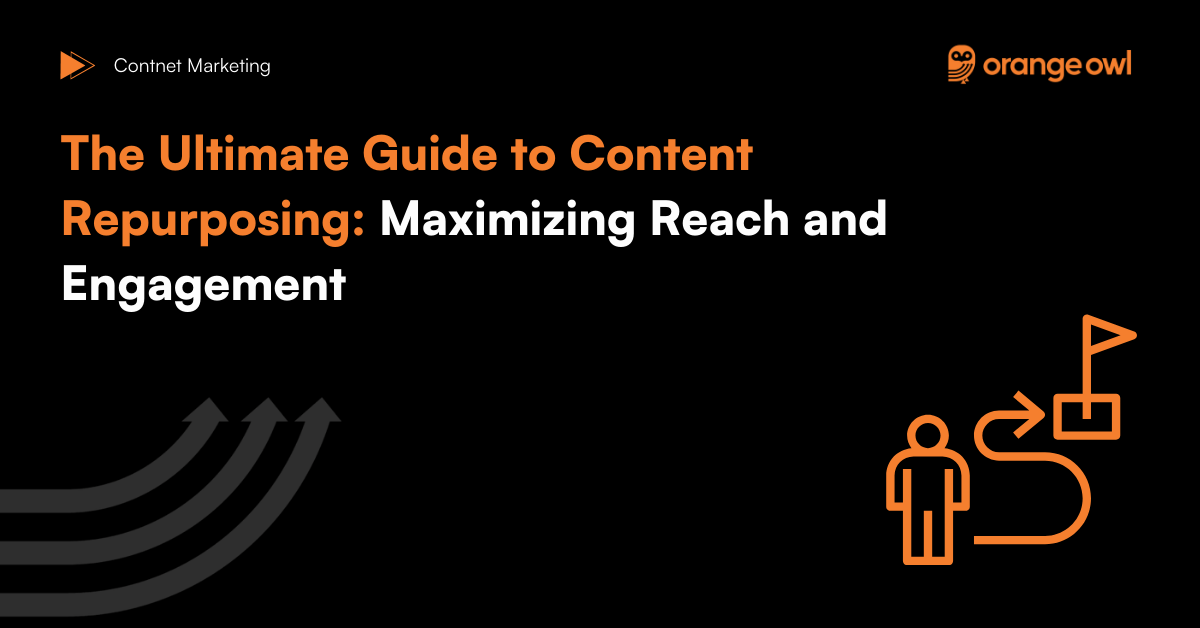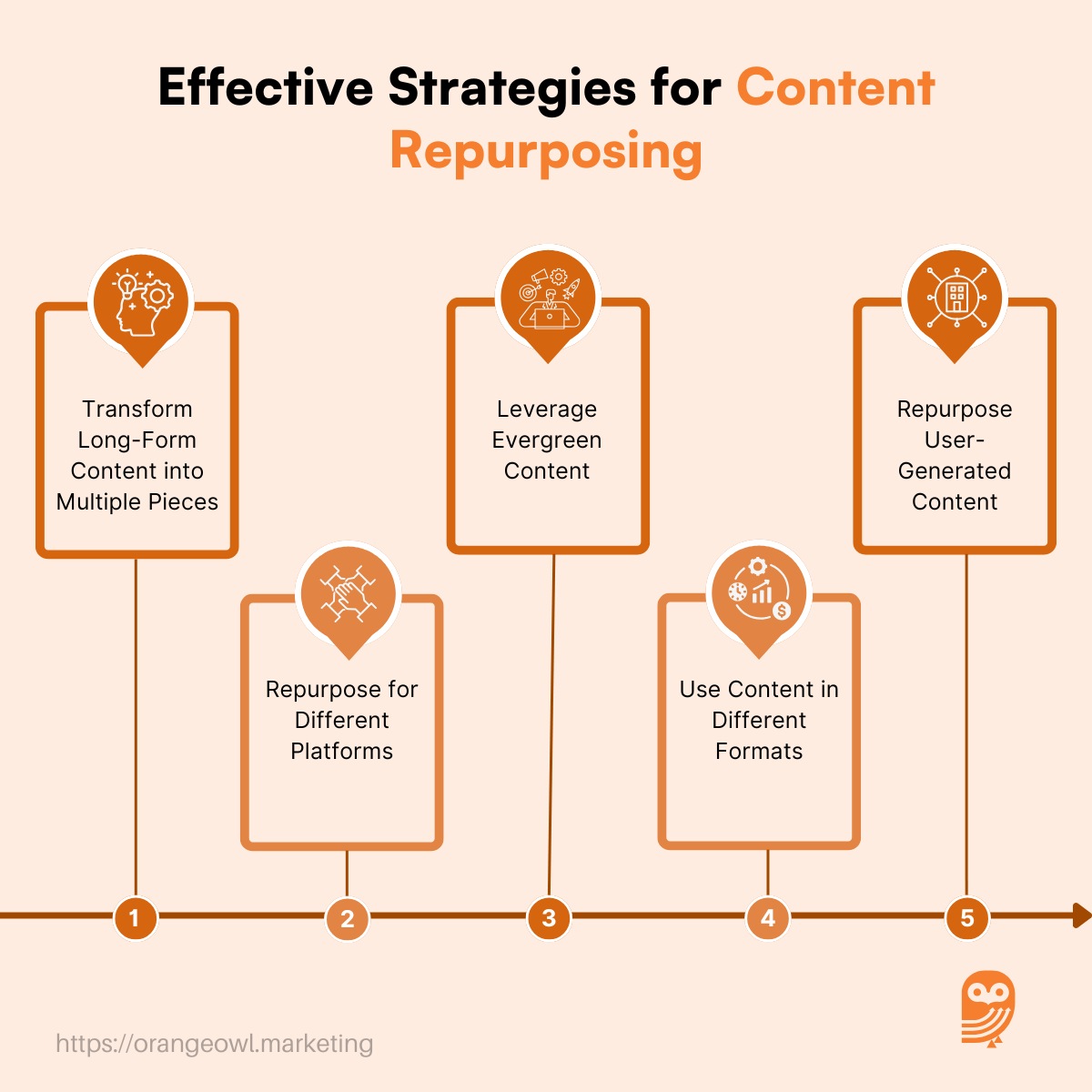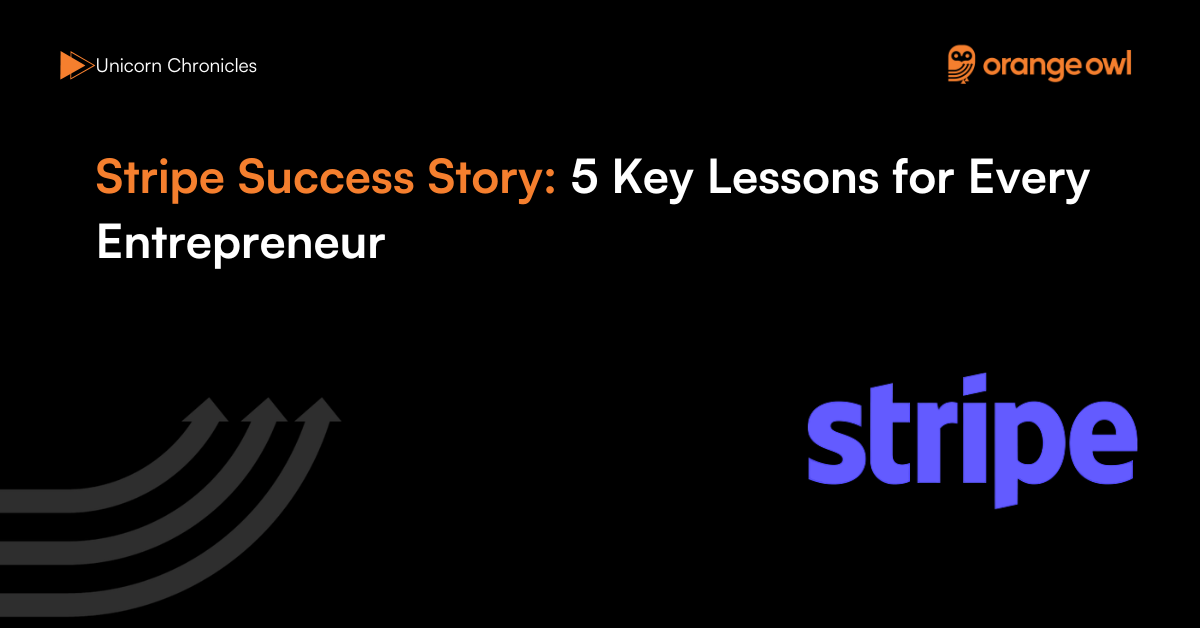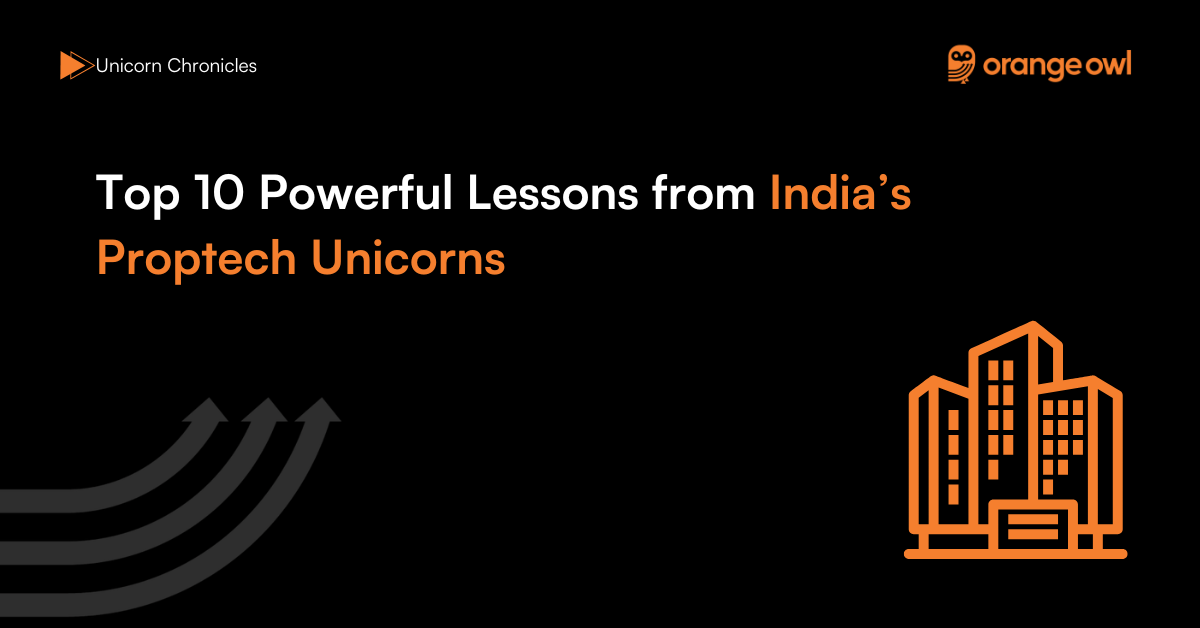The Ultimate Guide to Content Repurposing : Maximizing Reach and Engagement
Vivek Goel
February 7, 2025

Table of Contents
Introduction
Content creation is time-consuming and resource-intensive, yet many businesses fail to maximize the full potential of their content. That’s where content repurposing comes in. Instead of creating new content from scratch every time, repurposing allows you to leverage existing content in various formats to reach different audiences, boost engagement, and improve overall marketing efficiency.
According to a 2023 HubSpot report, 60% of marketers reuse content two to five times to increase reach and engagement. Additionally, data from the Content Marketing Institute suggests that repurposed content can generate up to 40% more leads than newly created content. These insights highlight the value of repurposing as an essential marketing strategy.
What is Content Repurposing?
Content repurposing is the practice of taking existing content and adapting it into new formats or distributing it across different platforms. This strategy ensures that your content remains relevant, reaches a broader audience, and continues to drive value over time.
Rather than letting a well-researched blog post, video, or report fade into obscurity after one use, repurposing allows you to breathe new life into your content. By tailoring content to different channels and formats, businesses can cater to varied audience preferences, maximize engagement, and extend the lifespan of their messaging.
For example, a blog post can be repurposed into a LinkedIn article, a podcast discussion, or an infographic for social media. Similarly, a webinar recording can be segmented into short video clips for platforms like Instagram Reels or TikTok. This approach not only enhances visibility but also helps reinforce key messages across multiple touchpoints, ensuring that your audience interacts with your brand in different ways.
Additionally, content repurposing allows businesses to capitalize on evergreen topics—content that remains valuable over time. By updating statistics, adding fresh insights, or reformatting the content, you can ensure that your existing assets continue to drive engagement long after they were first published.
How Content Repurposing Works
Content repurposing is a strategic way to extend the life of content, maximize audience engagement, and optimize resources. Here are some real-world examples and case studies of businesses successfully repurposing content.
Case Study 1: HubSpot – Turning Blog Content into a Lead Magnet
Challenge:
HubSpot, a leading inbound marketing software company, needed to generate leads and maintain a steady flow of high-quality content for its audience.
Content Repurposing Strategy:
✔ Step 1: They identified their best-performing blog posts on marketing strategies.
✔ Step 2: They compiled multiple blog posts into a comprehensive downloadable eBook (“The Ultimate Guide to Inbound Marketing”).
✔ Step 3: They created social media infographics summarizing key points and posted them on LinkedIn and Instagram.
✔ Step 4: They repurposed the eBook into a series of YouTube videos explaining inbound marketing principles.
✔ Step 5: They created an email series with insights from the eBook to nurture leads.
Results:
Increased lead generation by 35% through eBook downloads.
Improved engagement on LinkedIn, where infographics saw 60% more shares than standard posts.
Reduced content creation costs by repurposing existing materials instead of creating new content from scratch.
Case Study 2: Gary Vaynerchuk – 64 Pieces of Content from One Keynote Speech
Challenge:
Entrepreneur and marketing expert Gary Vaynerchuk needed to maximize content output without constantly creating new material.
Content Repurposing Strategy:
✔ Step 1: He recorded a one-hour keynote speech at a conference.
✔ Step 2: His team transcribed the speech and converted it into a long-form LinkedIn article.
✔ Step 3: The full keynote was uploaded as a YouTube video.
✔ Step 4: Short, impactful clips from the keynote were posted on Instagram Reels, TikTok, and Twitter.
✔ Step 5: Key quotes were turned into motivational social media posts.
✔ Step 6: Insights were converted into a podcast episode.
✔ Step 7: The entire session was repurposed into an email newsletter with key takeaways.
Results:
Created 64 pieces of content from a single keynote.
Boosted engagement across multiple platforms by tailoring content to each audience.
Expanded audience reach by catering to both video watchers, blog readers, and podcast listeners.
Case Study 3: Moz – Turning Research into Multi-Format Content
Challenge:
Moz, a leading SEO software company, wanted to maximize the impact of its annual SEO Industry Report without relying solely on a single publication.
Content Repurposing Strategy:
✔ Step 1: Moz conducted in-depth SEO research and published a detailed report on its website.
✔ Step 2: They converted the key findings into an infographic, making complex data more accessible.
✔ Step 3: They hosted a webinar discussing key insights and allowed attendees to ask questions.
✔ Step 4: They turned sections of the report into blog posts, each focusing on different aspects of SEO trends.
✔ Step 5: They repackaged the report as a SlideShare presentation for LinkedIn.
✔ Step 6: They posted bite-sized insights as Twitter threads and LinkedIn posts.
Results:
Increased website traffic by 42% during the campaign.
Improved social media engagement, with the infographic receiving thousands of shares.
Generated new leads through webinar registrations and report downloads.
Case Study 4: Buffer – From Podcast to Blog, Video, and Social Snippets
Challenge:
Buffer, a social media management platform, needed to expand the reach of its podcast without solely relying on audio listeners.
Content Repurposing Strategy:
✔ Step 1: Each podcast episode was transcribed using Descript and converted into a long-form blog post.
✔ Step 2: The most valuable insights were converted into short video clips for Instagram Reels and TikTok.
✔ Step 3: They pulled quotes and key takeaways and designed them as Twitter posts and LinkedIn carousels.
✔ Step 4: The podcast was converted into a YouTube video with captions.
✔ Step 5: The blog post was included in Buffer’s weekly newsletter.
Results:
Increased podcast listeners by 30% by reaching new audiences.
Boosted website traffic by 50% through blog posts.
Improved social media engagement, with short video clips outperforming traditional posts.
Benefits of Content Repurposing
1. Increases Reach – Different platforms have different audiences. Repurposing allows you to engage with users who prefer various content formats. For instance, a long-form blog post may not attract an Instagram audience, but repurposing key points into carousel posts or short Reels can reach a wider demographic.
2. Saves Time and Resources – Instead of creating new content from scratch, you can optimize and modify existing content. A whitepaper can be broken into multiple LinkedIn articles or newsletter snippets, saving hours of effort in content production.
3. Boosts SEO – More content formats mean more opportunities to rank in search engines. For example, a blog post repurposed into a YouTube video and embedded back into the blog can improve page rankings due to higher engagement and dwell time.
4. Reinforces Brand Messaging – Repeating core messages in different formats enhances brand recall and authority. A webinar repurposed into a podcast, an infographic, and a series of tweets ensures the same message reaches multiple audience segments effectively.
5. Maximizes ROI – By repurposing high-performing content, you extend its lifespan and maximize returns on your investment. A well-received case study, for example, can be converted into a video testimonial, a conference presentation, and a lead magnet e-book to continuously generate business leads.
Types of Content to Repurpose and How to Do It
1. Blog Posts – Transform long-form blog content into various formats:
- Extract key points to create bite-sized social media posts.
- Summarize the content into an infographic using tools like Canva.
- Convert the blog into an email newsletter with key takeaways.
- Repurpose the content into a short video script for YouTube or Instagram.
2. Videos – Adapt video content for broader reach:
- Transcribe a video and turn it into a blog post or LinkedIn article.
- Cut short snippets from the video for TikTok, Instagram Reels, or Facebook Shorts.
- Extract the audio and turn it into a podcast episode.
- Use screenshots from the video to create an image-based social media post.
3. Podcasts – Extend the value of audio content:
- Transcribe podcast episodes and repurpose them into blog articles.
- Highlight key quotes in visual graphics for Instagram or Pinterest.
- Break down podcast topics into Twitter threads for bite-sized insights.
- Compile multiple podcast episodes into an e-book or downloadable guide.
4. Webinars – Repurpose live session content effectively:
- Slice recorded webinars into short video clips for social media.
- Convert the presentation slides into a SlideShare or LinkedIn post.
- Extract key insights into a blog post or a newsletter.
- Offer a downloadable guide based on the webinar discussion.
5. Case Studies – Make business success stories more shareable:
- Summarize key achievements into customer testimonials for your website.
- Create an infographic showcasing data-driven results.
- Turn insights into a LinkedIn post or Twitter thread.
- Record a video testimonial featuring the client’s experience.
6. Whitepapers & E-books – Break down complex reports into digestible content:
- Segment the content into a blog series covering different sections.
- Extract stats and quotes for engaging LinkedIn or Twitter posts.
- Develop explainer videos summarizing key research findings.
- Offer shorter PDF guides derived from the whitepaper as lead magnets.
Effective Strategies for Content Repurposing
1. Transform Long-Form Content into Multiple Pieces
Long-form content, such as blog posts, research reports, and webinars, provides a wealth of information that can be broken down into smaller, digestible content pieces across various platforms.
Blog Posts: A single in-depth blog post can be repurposed into:
- An infographic summarizing key points for easy visual consumption.
- A short-form video (such as a TikTok, Instagram Reel, or YouTube Short) highlighting the main takeaways.
- A Twitter or LinkedIn thread breaks the content into multiple engaging posts.
Webinars and Live Sessions: Webinars contain valuable insights that can be repurposed into:
- A blog summary with key takeaways and insights.
- Video clips featuring highlights that can be shared on YouTube, LinkedIn, and Instagram.
- An email series with segmented insights sent to subscribers over a few weeks.
2. Repurpose for Different Platforms
Every social media platform has a unique content format and audience preference. Repurposing content to fit different platforms increases reach and engagement.
From LinkedIn to Instagram:
- Convert a text-heavy LinkedIn post into an Instagram carousel with eye-catching visuals and concise summaries.
From YouTube to Short-Form Video Platforms:
- Cut a long YouTube video into shorter clips for IGTV, TikTok, or Twitter.
- Extract audio snippets to use for Instagram or Facebook Stories.
From Podcasts to Blog Content:
- Transcribe a podcast episode into a detailed blog post with additional insights and links.
- Create pull quotes from the podcast to use in social media graphics.
3. Leverage Evergreen Content
Evergreen content remains relevant over time and can be periodically updated to maintain its value.
Updating Older Content:
- Refresh outdated blog posts with new research, statistics, and industry trends.
- Add new case studies or examples to keep the content relevant.
Repurposing Timeless Content:
- Convert a high-performing blog post into a downloadable PDF guide for lead generation.
- Expand the content into an interactive e-book with multimedia elements such as quizzes or videos.

4. Use Content in Different Formats
Reformatting content allows businesses to cater to different audience preferences.
From Blog to Video:
- Convert a detailed article into a script for a YouTube explainer video or a webinar.
- Use key insights to create a whiteboard animation video for social media.
From Research to Interactive Presentations:
- Reformat a research report into a SlideShare or PowerPoint presentation for LinkedIn audiences.
- Use data points to create polls and quizzes on Instagram Stories to drive engagement.
5. Repurpose User-Generated Content
User-generated content (UGC) builds credibility and authenticity. Businesses can maximize its impact by repurposing it creatively.
Showcasing Customer Reviews:
- Design visually appealing social media graphics featuring positive customer testimonials.
- Compile multiple reviews into a video testimonial montage for websites and social media.
Creating FAQ-Based Content:
- Gather frequently asked customer questions and turn them into:
- A comprehensive blog post addressing concerns in-depth.
- A video Q&A session or Instagram Live event where experts answer questions.
- Gather frequently asked customer questions and turn them into:
Tools to Help with Content Repurposing With Actionable Tips
Content repurposing can be significantly streamlined with the right tools. Here’s a detailed breakdown of some powerful tools along with actionable tips to maximize their effectiveness.
1. Canva – For Creating Graphics, Presentations, and Infographics
What It Does:
Canva is a user-friendly graphic design platform that allows you to create social media graphics, infographics, presentations, and more using pre-designed templates.
How to Use It for Content Repurposing:
✔ Transform blog posts into infographics – Summarize key points and present them visually.
✔ Convert testimonials into social media posts – Use attractive templates to highlight user reviews.
✔ Create carousel posts from LinkedIn content – Break down long-form posts into engaging slides.
✔ Make Pinterest pins from blog posts – Drive traffic by turning key insights into pin-worthy graphics.
Actionable Tip:
Use Canvas Brand Kit to maintain consistent fonts, colours, and logos across all repurposed content. This ensures brand uniformity across platforms.
2. Descript – For Transcribing Videos and Podcasts into Text
What It Does:
Descript is a powerful tool that transcribes video and audio files into text, allowing for easy editing and repurposing.
How to Use It for Content Repurposing:
✔ Turn podcasts into blog articles – Use Descript’s AI transcription to quickly convert spoken content into written form.
✔ Extract key quotes for social media – Find engaging snippets from interviews or speeches and use them in captions.
✔ Create subtitles for videos – Improve accessibility and engagement for social media video content.
✔ Repurpose a webinar into a LinkedIn article – Convert expert discussions into a thought-leadership piece.
Actionable Tip:
Use Descript’s “Overdub” feature to edit and enhance your video/audio without needing to re-record everything.
3. Lumen5 – For Turning Blog Posts into Engaging Videos
What It Does:
Lumen5 is an AI-powered video creation tool that helps convert text content into engaging video formats using stock footage, text overlays, and animations.
How to Use It for Content Repurposing:
✔ Convert blog articles into short-form videos – Ideal for social media platforms like TikTok, Instagram Reels, and YouTube Shorts.
✔ Turn a press release into an explainer video – Make corporate updates more digestible.
✔ Create teaser videos for long-form content – Summarize key takeaways from webinars, blog posts, or eBooks.
✔ Repurpose testimonials into promotional videos – Showcase customer success stories visually.
Actionable Tip:
Use Lumen5’s AI-driven content summarization to quickly identify the most important points from an article and turn them into video scenes.
4. Repurpose.io – For Automating the Distribution of Content Across Multiple Platforms
What It Does:
Repurpose.io automates the process of sharing content across platforms. It helps convert and distribute videos, podcasts, and live streams to different channels effortlessly.
How to Use It for Content Repurposing:
✔ Convert YouTube videos into Instagram Reels and TikToks – Repurpose long-form videos into short clips.
✔ Turn a Facebook Live session into a podcast – Automatically extract audio and publish it to podcast platforms.
✔ Repurpose Instagram stories as LinkedIn videos – Reuse engaging content across professional networks.
✔ Auto-publish content across multiple channels – Set up workflows to distribute content with minimal effort.
Actionable Tip:
Use Repurpose.io’s custom workflow automation to schedule content repurposing in advance, ensuring a steady content flow across multiple platforms.
5. Otter.ai – For AI-Powered Transcription of Audio and Video Content
What It Does:
Otter.ai is a real-time AI transcription tool that converts spoken content into text, making it easier to repurpose audio-based content into different formats.
How to Use It for Content Repurposing:
✔ Turn live meetings into blog summaries – Extract insights from expert discussions and convert them into shareable articles.
✔ Create LinkedIn posts from podcast conversations – Summarize industry discussions for professional audiences.
✔ Generate captions for videos – Improve accessibility and engagement by adding subtitles.
✔ Compile FAQ documents from webinars – Identify common audience questions and answer them in blog posts or social posts.
Actionable Tip:
Use Otter.ai’s speaker identification feature to automatically differentiate between multiple speakers in transcriptions, making it easier to format interview-based content.
Frequently Asked Questions (FAQs) about Content Repurposing
Content repurposing is the process of adapting existing content into different formats or for various platforms to maximize its reach and impact. It is important because it helps businesses save time, improve SEO, reach wider audiences, and reinforce brand messaging without constantly creating new content from scratch.
Repurposing content improves SEO by increasing the number of indexed pages on search engines, driving more traffic, and improving dwell time. For example, turning a blog post into a YouTube video or an infographic with embedded keywords can enhance search engine rankings.
Almost any type of content can be repurposed, including:
- Blog posts → Social media posts, infographics, videos
- Videos → Blog posts, short clips, podcasts
- Podcasts → Transcripts, Twitter threads, newsletters
- Webinars → Blog summaries, short video snippets, downloadable guides
- Case studies → Testimonials, LinkedIn posts, infographics
Choose content that:
- Has performed well in terms of engagement, traffic, or shares
- Is evergreen (remains relevant over time)
- Can be easily adapted into other formats
- Aligns with your audience’s preferences across different platforms
There’s no strict rule, but a good practice is to repurpose high-performing content every few months. Additionally, updating and republishing older content annually can help maintain relevance.
Yes! For example, a LinkedIn article can be repurposed into:
- A Twitter thread summarizing key points
- An Instagram carousel with visual takeaways
- A TikTok video highlighting insights
- A Pinterest infographic with key statistics
Break it down into smaller pieces:
- A blog post → Create 5-10 social media posts from key takeaways
- A webinar → Extract 3-5 video snippets for social media
- A whitepaper → Turn it into an infographic, SlideShare, or multiple blog articles
Some useful tools include:
- Canva (creating graphics and infographics)
- Descript (transcribing videos and podcasts)
- Lumen5 (converting blog posts into videos)
- Repurpose.io (automating content repurposing across platforms)
User-generated content (UGC) can be leveraged by:
- Turning customer testimonials into social media graphics
- Using positive reviews as website banners or email snippets
- Creating a highlight reel of customer success stories for YouTube or Instagram
No, as long as you add value. Repurposing is about presenting the same information in new ways for different audiences. A blog post repurposed into a video, for example, offers a fresh experience for those who prefer visual content over text.


